Book contents
- Frontmatter
- Contents
- List of Tables
- List of Figures
- Glossary
- Contributors
- 1 ASEAN Beyond the Crisis: A Bird's-eye View
- 2 East Asia: Crisis and Recovery
- 3 Competitiveness and Sustainable Growth in ASEAN
- 4 ASEAN Free Trade Area: Progress and Challenges
- 5 ASEAN Investment Area: Progress and Challenges
- 6 Financial and Macroeconomic Co-operation in ASEAN: Issues and Policy Initiatives
- 7 Food Security in ASEAN
- 8 ASEAN Co-operation and the Environment
- 9 ASEAN and the International Trading System: Regional Trade Arrangement vs. the WTO
- 10 ASEAN and Its Inter-Regional Economic Links
- Appendix I ASEAN's Relevance: Has It Become Questionable?
- Appendix II Is ASEAN Still Relevant? Some Thoughts from a European Perspective
- Index
9 - ASEAN and the International Trading System: Regional Trade Arrangement vs. the WTO
Published online by Cambridge University Press: 03 November 2017
- Frontmatter
- Contents
- List of Tables
- List of Figures
- Glossary
- Contributors
- 1 ASEAN Beyond the Crisis: A Bird's-eye View
- 2 East Asia: Crisis and Recovery
- 3 Competitiveness and Sustainable Growth in ASEAN
- 4 ASEAN Free Trade Area: Progress and Challenges
- 5 ASEAN Investment Area: Progress and Challenges
- 6 Financial and Macroeconomic Co-operation in ASEAN: Issues and Policy Initiatives
- 7 Food Security in ASEAN
- 8 ASEAN Co-operation and the Environment
- 9 ASEAN and the International Trading System: Regional Trade Arrangement vs. the WTO
- 10 ASEAN and Its Inter-Regional Economic Links
- Appendix I ASEAN's Relevance: Has It Become Questionable?
- Appendix II Is ASEAN Still Relevant? Some Thoughts from a European Perspective
- Index
Summary
Introduction
This chapter examines ASEAN regional economic arrangements in the light of the emerging global trading system operating within the multilateral framework of the World Trade Organization (WTO). It focuses on the issues to keep in mind when a government of an ASEAN country considers the relation between regional integration and the multilateral system. In so doing, it looks at the prevailing reality in ASEAN and the WTO. It assumes that it is the intention of the ASEAN states to continue the economic co-operation that has been undertaken since its creation but also to enjoy the benefits of WTO membership.
In this study, the question of regionalism versus multilateralism is posed in the context of internal ASEAN processes. However, the debate on regionalism has been pulled by two external factors which are influencing ASEAN in distinct but somewhat related ways. The two factors are the European model, which has been used as a reference point (not appropriately), and an example for achieving growth and prosperity, and, on the other hand, the pull of the global system, in which ASEAN has a strong long-term interest and from which it has profited. Against that background, this study argues for a specific approach to deal with regionalism and the multilateral system which is more appropriate for ASEAN. That approach requires regional integration be viewed from the specific context of ASEAN realities.
In view of the extensive experience in European economic and political integration, which has made it a reference point for other integration endeavours, we shall first briefly look at the European experience. The creation of the European Economic Community had an impact on the thinking about economic integration in other regions and also the development of the multilateral system under the General Agreement on Tariffs and Trade (GATT). We shall therefore look at the GATT/WTO system and examine regional economic integration in the light of the multilateral rules and study the way that regional arrangement has been treated in the GATT/ WTO system over time.
- Type
- Chapter
- Information
- ASEAN Beyond the Regional CrisisChallenges and Initiatives, pp. 203 - 242Publisher: ISEAS–Yusof Ishak InstitutePrint publication year: 2001

